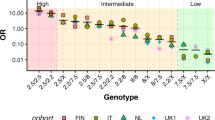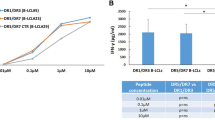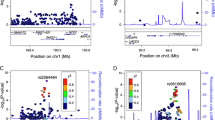Abstract
Genome-wide scans have detected linkage to celiac disease (CD) in several genomic locations, including 19q13.4. Killer immunoglobulin-like receptor (KIR) genes map to the region and encode receptors of natural killer (NK) cells and certain T cells that modulate cytolitic activity through interactions with HLA class I ligands, participating in the innate immune response. We performed KIR genotyping in a group of 70 CD patients of Basque origin and compared gene content, genotype and haplotype frequencies to ethnically matched blood-donors. The frequency of gene combination KIR2DL5B+/KIR2DL5A− was significantly higher in the disease group, and this result was confirmed in a second group of 343 CD patients and 160 controls of Spanish origin, suggesting an implication of this ‘unexpressed’ gene with increased susceptibility to CD (combined OR of 3.63 (95% CI: 1.76–7.51; P=0.0004)), possibly due to the lack of an efficient inhibitory signal. Our results support the role of the KIR gene cluster in celiac disease and replicate the CD-susceptibility locus at 19q13.4.
This is a preview of subscription content, access via your institution
Access options
Subscribe to this journal
Receive 6 digital issues and online access to articles
$119.00 per year
only $19.83 per issue
Buy this article
- Purchase on Springer Link
- Instant access to full article PDF
Prices may be subject to local taxes which are calculated during checkout


Similar content being viewed by others
References
Sollid LM . The molecular basis of celiac disease. Annu Rev Immunol 2000; 18: 53–81.
Trier JS . Diagnosis of celiac sprue. Gastroenterology 1998; 115: 211–216.
Feighery C . Coeliac disease. BMJ 1999; 319: 236–239.
Marsh MN . Mucosal pathology in gluten sensitivity. In: Marsh MN (ed). Coeliac Disease. Blackwell Scientific Publications: Oxford, 1992, pp 136–191.
Vitoria JC, Arrieta A, Astigarraga I, García-Masdeval D, Rodríguez-Soriano J . Serological markers as screening test in family menbers of patients with coeliac disease. J Pediatr Gastroenterol Nutr 1994; 19: 304–309.
Petronzelli F, Bonamico M, Ferrante P, Grillo R, Mora B, Mariani P et al. Genetic contribution of the HLA region to the familial clustering of coeliac disease. Ann Hum Genet 1997; 61: 307–317.
Djilali-Saiah I, Schmitz J, Harfouch-Hammoud E, Mougenot JF, Bach JF, Caillat-Zucman S . CTLA-4 gene polymorphism is associated with predisposition to coeliac disease. Gut 1998; 43: 187–189.
Clot F, Fulchignoni-Lataud MC, Renoux C, Percopo S, Bouguerra F, Babron MC et al. Linkage and association study of the CTLA-4 region in coeliac disease for Italian and Tunisian populations. Tissue Antigens 1999; 54: 527–530.
Martin-Pagola A, Perez de Nanclares G, Vitoria JC, Bilbao JR, Ortiz L, Zubillaga P et al. No association of CTLA4 gene with celiac disease in the Basque population. J Pediatr Gastroenterol Nutr 2003; 37: 142–145.
Haimila K, Smedberg T, Mustalahti K, Maki M, Partanen J, Holopainen P . Genetic association of coeliac disease susceptibility to polymorphisms in the ICOS gene on chromosome 2q33. Genes Immun 2004; 5: 85–92.
Rueda B, Martinez A, Lopez-Nevot MA, Mas-Fontao A, Paco L, Ortega E et al. A functional variant of IFNgamma gene is associated with coeliac disease. Genes Immunol 2004; 5: 517–519.
Fernandez L, Fernandez-Arquero M, Gual L, Lazaro F, Maluenda C, Polanco I et al. Triplet repeat polymorphism in the transmembrane region of the MICA gene in celiac disease. Tissue Antigens 2002; 59: 219–222.
Bilbao JR, Martin-Pagola A, Vitoria JC, Zubillaga P, Ortiz L, Castano L . HLA-DRB1 and MHC class 1 chain-related A haplotypes in Basque families with celiac disease. Tissue Antigens 2002; 60: 71–76.
Zhong F, McCombs CC, Olson JM, Elston RC, Stevens FM, McCarthy CF et al. An autosomal screen for genes that predispose to celiac disease in the western counties of Ireland. Nat Genet 1996; 14: 329–333.
Greco L, Corazza G, Babron MC, Clot F, Fulchignoni-Lataud MC, Percopo S et al. Genome search in celiac disease. Am J Hum Genet 1998; 62: 669–675.
King AL, Yiannakou JY, Brett PM, Curtis D, Morris MA, Dearlove AM et al. A genome-wide family-based linkage study of coeliac disease. Ann Hum Genet 2000; 64: 479–490.
Maiuri L, Ciacci C, Ricciardelli I, Vacca L, Raia V, Auricchio S et al. Association between innate response to gliadin and activation of pathogenic T cells in coeliac disease. Lancet 2003; 362: 30–37.
Martin-Pagola A, Perez-Nanclares G, Ortiz L, Vitoria JC, Hualde I, Zaballa R et al. MICA response to gliadin in intestinal mucosa from celiac patients. Immunogenetics 2004; 56: 549–554.
Gianfrani C, Auricchio S, Troncone R . Adaptive and innate immune responses in celiac disease. Immunol Lett 2005; 99: 141–145.
Carrington M, Norman P . The KIR Gene Cluster. National Library of Medicine (US), National Center for Biotechnology Information: Bethesda, MD, 2003.
Moretta L, Moretta A . Killer immunoglobulin-like receptors. Curr Opin Immunol 2004; 16: 626–633.
Martin MP, Bashirova A, Traherne J, Trowsdale J, Carrington M . Cutting edge: expansion of the KIR locus by unequal crossing over. J Immunol 2003; 171: 2192–2195.
Uhrberg M, Valiante NM, Shum BP, Shilling HG, Lienert-Weidenbach K, Corliss B et al. Human diversity in killer cell inhibitory receptor genes. Immunity 1997; 7: 753–763.
Shilling HG, Guethlein LA, Cheng NW, Gardiner CM, Rodriguez R, Tyan D et al. Allelic polymorphism synergizes with variable gene content to individualize human KIR genotype. J Immunol 2002; 168: 2307–2315.
Hsu KC, Liu XR, Selvakumar A, Mickelson E, O'Reilly RJ, Dupont B . Killer Ig-like receptor haplotype analysis by gene content: evidence for genomic diversity with a minimum of six basic framework haplotypes, each with multiple subsets. J Immunol 2002; 169: 5118–5129.
Uhrberg M . The KIR gene family: life in the fast lane of evolution. Eur J Immunol 2005; 35: 10–15.
Yen JH, Moore BE, Nakajima T, Scholl D, Schaid DJ, Weyand CM et al. Major histocompatibility complex class l-recognizing receptors are disease risk gene in rheumatoid arthritis. J Exp Med 2001; 193: 1159–1167.
Namekawa T, Snyder MR, Yen JH, Goehring BE, Leibson PJ, Weyand CM et al. Killer cell activating receptors function as costimutatory molecules on CD4 CD28null T cells expanded in rheumatoid arthritis. J Immunol 2000; 165: 1138–1145.
van der Slik AR, Koeleman BP, Verduijn W, Bruining GJ, Roep BO, Giphart MJ . KIR in type 1 diabetes: disparate distribution of activating and inhibitory natural killer cell receptors in patients versus HLA-matched control subjects. Diabetes 2003; 52: 2639–2642.
Martin MP, Nelson G, Lee JH, Pellet F, Gao X, Wade J et al. Cutting edge: susceptibility to psoriatic arthritis: influence of activating killer Ig-like receptor genes in the absence of specific HLA-C alleles. J Immunol 2002; 169: 2818–2822.
Luszczek W, Manczak M, Cislo M, Nockowski P, Wisniewski A, Jasek M . Gene for the activating natural killer cell receptor KIR2DS1, is associated with Psoriasis vulgaris. Hum Immunol 2004; 67: 758–766.
Moodie SJ, Norman PJ, King AL, Fraser JS, Curtis D, Ellis HJ et al. Analysis of candidate genes on chromosome 19 in coeliac disease: an association study of the KIR and LILR gene clusters. Eur J Immunogenet 2002; 29: 287–291.
Comas D, Mateu E, Calafell F, Perez-Lezaun A, Bosch E, Martinez-Arias R et al. HLA class I and class II DNA typing and the origin of basques. Tissue Antigens 1998; 51: 30–40.
Aguirre A, Vicario A, Mazon LI, Estomba A, Martinez de Pancorbo M, Arrieta Pico V et al. Are the basques a single and a unique population? Am J Hum Genet 1991; 49: 450–458.
Bertranpetit J, Cavalli-Sforza LL . A genetic reconstruction of the history of the population of the Iberian Peninsula. Ann Hum Genet 1991; 55: 51–67.
Santin I, Perez de Nanclares G, Calvo B, Gaafar A, Castano L, GEPV-N et al. Killer cell immunoglobulin-like receptor (KIR) genes in the Basque population: association study of KIR gene contents with type 1 diabetes mellitus. Hum Immunol 2006; 67: 118–124.
Jiang K, Zhu FM, Lv QF, Yan LX . Distribution of killer cell immunoglobulin-like receptor genes in the Chinese han population. Tissue Antigens 2005; 65: 556–563.
Vilches C, Rajalingam R, Uhrberg M, Gardiner CM, Young NT, Parham P . KIR2DL5, a novel killer-cell receptor with a D0-D2 configuration of Ig-like domains. J Immunol 2000; 164: 5797–5804.
Gomez-Lozano N, Gardiner CM, Parham P, Vilches C . Some human KIR haplotypes contain two KIR2DL5 genes: KIR2DL5A and KIR2DL5B. Immunogenetics 2002; 54: 314–319.
Vilches C, Gardiner CM, Parham P . Gene structure and promoter variation of expressed and nonexpressed variants of the KIR2DL5 gene. J Immunol 2000; 165: 6416–6421.
Robinson J, Waller MJ, Stoehr P, Marsh SGE . IPD – the immuno polymorphism database. Nucleic Acids Res 2005; 331: D523–D526.
Martin MP, Nelson G, Lee JH, Pellett F, Gao X, Wade J et al. Cutting edge: susceptibility to psoriatic arthritis: influence of activating killer Ig-like receptor genes in the absence of specific HLA-C alleles. J Immunol 2002; 169: 2818–2822.
Momot T, Koch S, Hunzelmann N, Krieg T, Ulbricht K, Schmidt RE et al. Association of killer cell immunoglobulin-like receptors with scleroderma. Arth Rheum 2004; 50: 1561–1565.
Suzuki Y, Hamamoto Y, Ogasawara Y, Ishikawa K, Yoshikawa Y, Sasazuki T et al. Genetic polymorphisms of killer cell immunoglobulin-like receptors are associated with susceptibility to psoriasis vulgaris. J Investig Dermatol 2004; 122: 1133–1136.
Stewart CA, Laugier-Anfossi F, Vely F, Saulquin X, Riedmuller J, Tisserant A et al. Recognition of peptide-MHC class I complexes by activating killer immunoglobulin-like receptors. Proc Nat Acad Sci USA 2005; 102: 13224–13229.
Williams AP, Bateman AR, Khakoo SI . Hanging in the balance. KIR and their role in disease. Mol Interv 2005; 5: 226–240.
Acknowledgements
This work was partially funded by Grants 03/11032 from the Basque Department of Health and PI04/1170 from the Instituto de Salud Carlos III of the Spanish Ministry of Health. IS is a predoctoral fellow supported by a grant from the University of the Basque Country. GPN is a FIS researcher supported by the Spanish Ministry of Health grant 03/0064. JRB is a co-funded by the Spanish Ministry of Health-Human Resources Stabilization Program.
Author information
Authors and Affiliations
Corresponding author
Rights and permissions
About this article
Cite this article
Santin, I., Castellanos-Rubio, A., Perez de Nanclares, G. et al. Association of KIR2DL5B gene with celiac disease supports the susceptibility locus on 19q13.4. Genes Immun 8, 171–176 (2007). https://doi.org/10.1038/sj.gene.6364367
Received:
Revised:
Accepted:
Published:
Issue Date:
DOI: https://doi.org/10.1038/sj.gene.6364367
This article is cited by
-
Searching for genes influencing a complex disease: the case of coeliac disease
European Journal of Human Genetics (2008)



